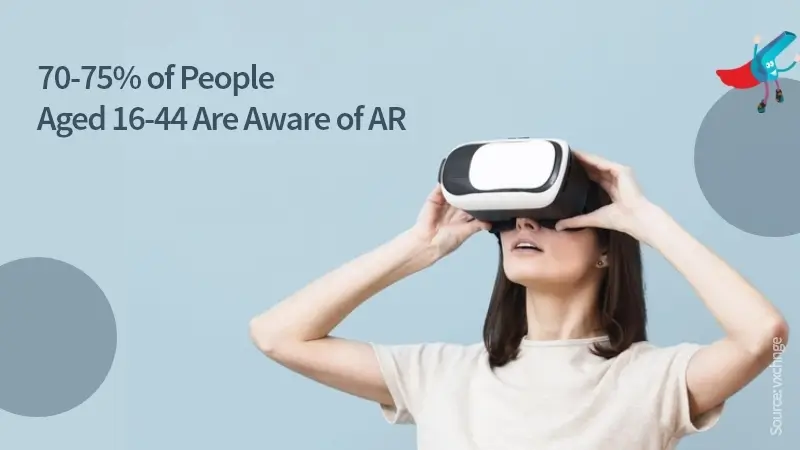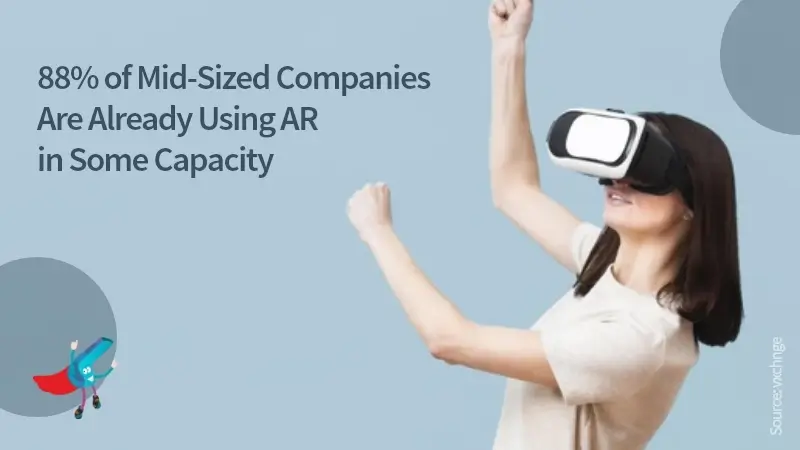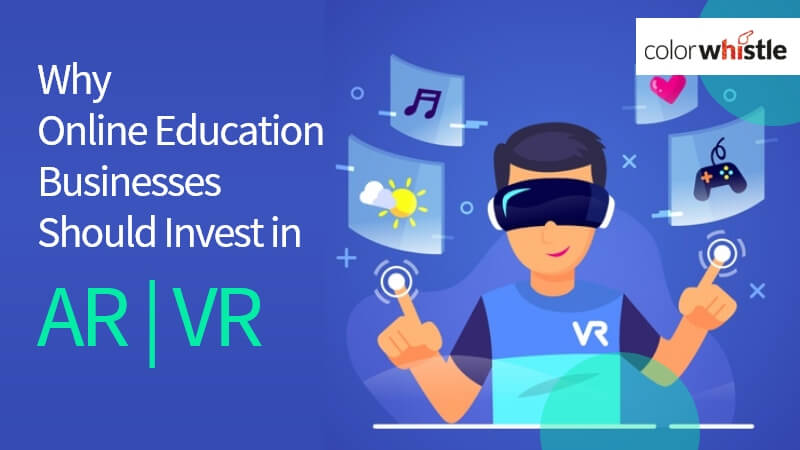AR/VR in education websites has made learning a breeze. Enhanced interactivity, improved retention, increased learning performance, etc., are key reasons why businesses should integrate AR/VR into education websites.
AR/VR in education websites make ‘learning’ more interactive and engaging. AR allows you to see virtual objects in the real world, like adding digital information to a physical book. VR, on the other hand, creates a completely digital world for your students to explore and interact with.
Learners enjoy the immersive learning methods and are more likely to stay connected to your online education website. In this post, we have lined up the vital role played by AR/VR in education websites. By using AR and VR on educational websites, students can better visualize and understand complex concepts in a fun and immersive way.
1. What is AR/VR Technology?
Before learning about the importance of AR/VR in education websites, let’s take a sneak peek at what AR/VR is.
According to Wikipedia, ‘Augmented reality (AR) is an interactive experience of a real-world environment where the objects that reside in the real world are enhanced by computer-generated perceptual information, sometimes across multiple sensory modalities, including visual, auditory, haptic, somatosensory and olfactory.’
For instance, kids kicking an alien spacecraft in online games wearing Google Glasses.
On the other side, according to Marxent, ‘Virtual Reality (VR) is the use of computer technology to create a simulated environment. Unlike traditional user interfaces, VR places the user inside an experience. Instead of viewing a screen in front of them, users are immersed and able to interact with 3D worlds’. Using VR devices such as HTC Vive, Oculus Rift, and Google Cardboard, users can be immersed in virtual environments.
The combined version of AR/VR becomes the backbone of the education website. It has shifted traditional learning practices and has laid an active learning platform for many learners.
As AR/VR help capture the attention of learners, professional educators, tutors, and teachers consider it to be a tremendous breakthrough.

Also Read
2. AR in Education Websites
Augmented reality enables learners to proactively participate instead of being passive recipients of written information. This well-optimized technology enhances abilities like creative skills, problem-solving techniques, critical thinking, iterative testing, and many more among learners.
AR boosts the learners’ engagement, improves their learning performance, and encourages them to learn new concepts on their own without searching content libraries, scouring the internet, or finding an expert.
Marketresearch.com reports that the overall market for AR was valued at $2.35 billion in 2015 and is expected to reach $117.4 billion by 2022.
Let’s take a look at the use cases of augmented reality in various online education businesses.
Augmented Reality Apps in Schools
AR implementation in online schools makes students experience an interactive learning session. For instance, Polytechnic Institute of Leiria in Portugal integrates AR into math lessons and students report it as helpful, easy, and interesting.
Here, we have curated the powerful AR apps and tools that will turn your virtual classroom into an engaging platform.
- Elements 4D by DAQRI studio is an Android/iOS app for teaching elementary, secondary and high-school Chemistry
- Anatomy 4D and Corinth Micro Anatomy is an Android/iOS/Windows app for training medical students
- Math Alive and ZooKazam help kids learn numbers and animals
Augmented Reality Apps in Medical Training
You can improve both the knowledge and skills of medical students by taking advantage of augmented reality. For example, with the help of AR technology, it is possible to create human body models and practice virtual surgeries.
Here, we have listed out a few AR apps that help in enhancing learning in medical fields.
- Touch Surgery tool makes users practice virtual surgeries on virtual patients
- With the use of Froggipedia app, you can show the anatomy of frogs through a guided virtual dissection
Likewise, AR technology provides a mammoth of benefits in space learning, product manufacturing classes, military training, tailoring, painting, and many other learning niches.

Also Read
3. VR in Education Websites
It is well-known that virtual reality has the potential to revolutionize traditional learning practices. VR allows learners to interact with the learning material in a virtual environment. This intensifies the engagement and encourages the trainees to learn things efficiently in a quick time.
Moreover, VR provides lots of advantages such as enhanced engagement, improved retention, experiential learning, and more. A report from Marketresearch.com states that the adoption of VR products was valued at $1.37 billion in 2015 and is expected to reach $33.9 billion by 2022.
Google offers educational field trips to students provided with VR headsets. Microsoft immerses the players into Minecraft to help children express their creativity by exploring the virtual world. Also, Unimersiv provides VR educational content for businesses and institutions.
Here, we have listed a few real-time examples that show the importance of VR technology in learning.
- Conquer Mobile tests VR surgical training simulations to help medical trainees in doing surgeries to virtual human models
- NASA uses VR for preparing astronauts for upcoming missions
- Toyota teaches the trainees to drive with their TeenDrive365 campaign to deliver immersive driving experiences without endangering the drivers, vehicles, and pedestrians
- US Military uses VR to train soldiers to reduce training expenses
- Siemens provides employee training simulations using VR technology
Virtual Reality Apps in Schools
If you are planning to enhance your curriculum, here are educational apps and tools that can help innovate the way you teach in the online classrooms.
- Titans of Space is an interactive VR app to teach your students about the solar system
- Anatomyou helps you to teach about respiratory, digestive, circulatory, and other human body systems
- Tiltbrush is a useful VR app for boosting creativity among students related to arts, crafts, paintings, drawings, etc
Also, there is a wide collection of VR apps related to military training, medical treatment training, and others that help create an active learning environment. With the help of effective AR technology, you can make learners show great involvement during sessions.
Also Read
4. Why should You Integrate AR/VR in Education Websites?
Using AR/VR in education websites, you can encourage learners to explore and learn at their own pace. VR/AR learning apps combine digital technologies with learning to empower learners for gaining knowledge and skills effectively.
Further, AR/VR allows you to teach learners through gamification and keep them engaged with no distractions. You can offer extended teaching methods with 3D design, modeling, and presentations at an affordable price.
Hence, by embedding AR/VR in your education website, you can help students excel in the online business world. According to a report from Dell future workforce global study, over 66% of the global workforce would use AR/VR products as a training tool.
In this ever-changing digital environment, AR/VR have made the education industry to fly-high in the online space. With the amazing AR/VR, traditional blackboards and two-dimensional textbook images are replaced with the technology-enabled curriculums and smartboards. Therefore, introducing AR/VR for your e-learning business is a lucrative investment.
Looking for EduTech Digital Services?
Seize and experience the transformative impact of EduTech digital services with ColorWhistle.
Bottom Line
Investing in AR/VR technology for your online education website is worthwhile! AR/VR in online education boosts engagement, improves flexibility, enhances understanding skills, provides seamless learning experiences, and many more to the learners.
To get suggestions and ideas on how to implement AR/VR technologies to your online e-learning platform we can also guide you through our AI consulting services. We can suggest you with the suitable AI implementations tailoring your needs.
If you have plans to convert your online education platform into an engaging medium, then do not hesitate to reach our team. At ColorWhistle, we have designed, developed, and promoted online education websites of all shapes and sizes.
Feel free to leave us a message or give us a call +1 (210) 787-3600. Our team is happy to help!
As an online education business owner, what would be the main reason for you to invest in AR/VR? Let us know in the comments section below.





